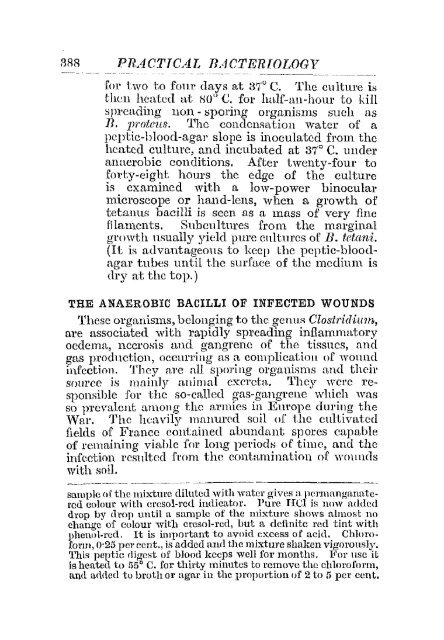AGf~ICULTURAL RESEARCH, PUSA.
AGf~ICULTURAL RESEARCH, PUSA.
AGf~ICULTURAL RESEARCH, PUSA.
Create successful ePaper yourself
Turn your PDF publications into a flip-book with our unique Google optimized e-Paper software.
BR8 PRACTICAL BACTERIOLOGY<br />
for two to four days at B7'Q C. The culture is<br />
then heaLed at HOl) C. for Imli-an-hour to Ull<br />
spreading non - sporing organisms such as<br />
B. proteus. 'rhc condensation water of a<br />
peptic-hlood-agar slope is inoculated from the<br />
heated culture, and incubated at B7° C. under<br />
anaerol?ic conditions. After twenty-four to<br />
forty-elght hours the edge of the culture<br />
is. examined with a low-power binocular<br />
Ilncroscope or hand-lens, when a growth of<br />
tetanus bacilli is seen as It mass of very fllle<br />
filaments. Subcultures from. the marginal<br />
growth usually yield pure cnlturcs of B. tetanL<br />
(It is advantageous to keep Lhe peptic-bloodagar<br />
tubes until the surface of the mcdium is<br />
dry at the top.)<br />
THE ANAEROBIC BACILLI OF INFECTED WOUNDS<br />
l'hesc organisms, belonging to the genus Clostridium,<br />
are associated with rapidly spreading' inflammatory<br />
oedema, necrosis and gangrene of the tissues, and<br />
gas production, occurring as a complication of wound<br />
infection. They are all sporing organisms and their<br />
source is mainly animal exercta. 'f'hey were responsible<br />
for the so-called gas-gangrene which Was<br />
so prc\ralcnt among the armies in Europe during the<br />
War. The heavily manured soil of the cultivated<br />
fwlds of France contained abundant spores capable<br />
of remaining viahlc for long periods of time, and the<br />
infection resulted from the contamination of wounds<br />
with soil.<br />
samplc (If the mixture diluted with water gives a pCl'Il1anganatcred<br />
colour with cresol-red iudicator. Purc Hel iH now alltled<br />
drop by (hop until ll. sample of the mixture shows almost no<br />
change of colour with cresol-red, but a definite red tint with<br />
phenol.reel. It is important to avoid excess of ncid. Chloro.<br />
form, 0·25 pCI' cent., is added and the mixtul'e shaken vigorously.<br />
'L'his peptic digest of blood ],;ceps well for months. For llse it<br />
is hentcd to 55° C. for thirty minutes to rcmove the chloroform,<br />
and added tu bruth 01· agar in the proportiuIl of 2 to () per cent.

















